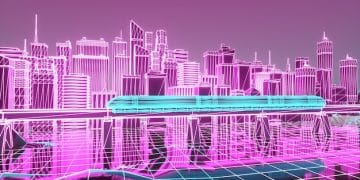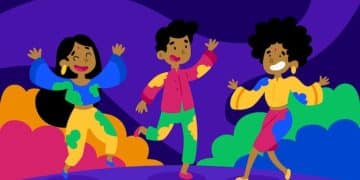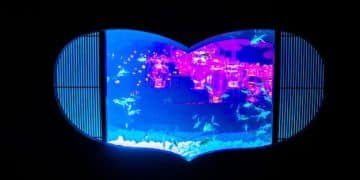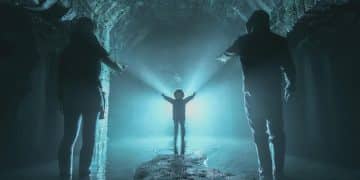The Future of Animation: Latest Trends in Animated Series
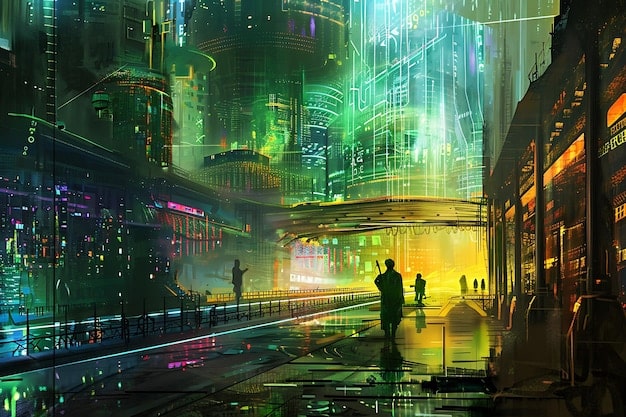
The future of animation is being dynamically shaped by groundbreaking technological advancements and evolving storytelling approaches, pushing the boundaries of creativity and audience engagement in animated series worldwide.
The landscape of visual entertainment is in constant flux, and few mediums demonstrate this dynamism as vividly as animation. As we delve into The Future of Animation: Exploring the Latest Trends in Animated Series, it becomes clear that innovation isn’t just a buzzword, but the very essence driving this vibrant art form forward. From novel production techniques to increasingly sophisticated narratives, animated series are redefining what’s possible, captivating audiences with unparalleled creativity and pushing traditional boundaries.
Breaking new ground: revolutionary animation techniques
The very fabric of animated storytelling is being rewoven by a tapestry of revolutionary techniques. These advancements aren’t merely about aesthetics; they are fundamentally altering production workflows, empowering creators, and enriching the viewer’s experience in unforeseen ways. Understanding these shifts is key to grasping the trajectory of the medium.
One of the most significant leaps forward has been in real-time rendering and virtual production. This allows animators to see their work come to life instantly, fostering a more iterative and collaborative process reminiscent of live-action filmmaking. The ability to manipulate virtual environments and characters on the fly dramatically reduces production time and costs, opening doors for smaller studios and independent creators to compete on a global scale.
Virtual production and real-time rendering
- Instant Feedback: Animators can visualize and adjust scenes, lighting, and character movements in real-time, streamlining the creative flow.
- Cost Efficiency: Reduced rendering times translate directly into lower operational costs and faster delivery schedules.
- Creative Freedom: Experimentation becomes less daunting when changes can be previewed immediately, fostering innovation.
Another powerful trend is the evolution of Artificial Intelligence (AI) and Machine Learning (ML) in animation pipelines. While not replacing human artists, AI is becoming an invaluable assistant, automating mundane tasks, generating preliminary character movements, or even assisting in background creation. This frees up animators to focus on the more nuanced and creative aspects of their craft, elevating the overall quality of series.
The integration of AI-powered tools, from automated lip-syncing to advanced motion capture processing, exemplifies how technology can augment human skill. These tools not only accelerate production but also ensure consistency across large-scale projects, allowing for more ambitious and detailed animated worlds to be realized.
Evolving narratives: beyond children’s entertainment
For decades, animation was largely pigeonholed as a genre primarily for children. While it continues to delight young audiences, a profound shift has taken place. Today’s animated series are increasingly catering to adult audiences, tackling complex themes, mature storytelling, and diverse genres with a sophistication once reserved for live-action dramas.
This evolution is not just about adult content, but about narrative depth and character complexity. Series are exploring nuanced relationships, societal issues, psychological dramas, and philosophical questions, demonstrating animation’s capacity to be a powerful vehicle for profound storytelling. The medium’s inherently flexible nature allows for visual metaphors and fantastical elements that can heighten emotional impact and thematic resonance in unique ways.
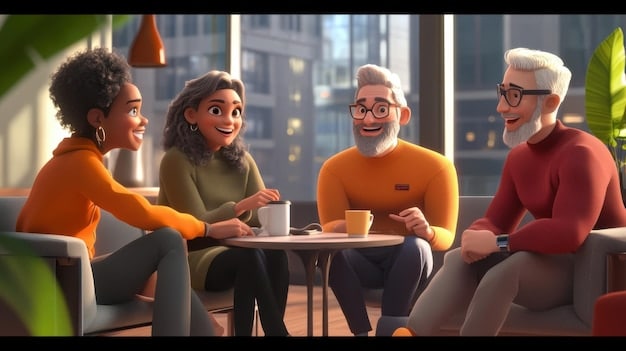
Adult-oriented themes and genres
- Psychological Depth: Characters are portrayed with intricate backstories and internal conflicts, mirroring real-world complexities.
- Genre Expansion: From sci-fi thrillers to dark comedies and historical dramas, animation is embracing a vast array of genres.
- Social Commentary: Many series now use animation as a potent tool to address and critique contemporary social and political issues.
The accessibility of streaming platforms has played a crucial role in this transformation. With fewer traditional broadcast constraints, creators have been empowered to take greater risks with their storytelling, producing content that appeals to niche demographics and challenging preconceived notions about animated formats. This freedom has fostered an environment ripe for experimentation, leading to a golden age of adult animation.
Furthermore, the creative talent flowing into animation has diversified significantly. Writers and directors with backgrounds in drama and independent film are bringing their unique perspectives, enriching the narrative landscape and pushing the boundaries of what is expected from an animated series. This interdisciplinary exchange is a vital ingredient in the medium’s current renaissance.
Global appeal: diverse voices and international collaborations
The animation industry is no longer confined by geographical borders. A significant trend currently shaping The Future of Animation: Exploring the Latest Trends in Animated Series is the unprecedented rise of diverse voices and the flourishing of international collaborations. This global exchange enriches the medium, bringing fresh perspectives, unique artistic styles, and universal stories to screens around the world.
Korean, Japanese, European, and Latin American animation studios are producing content that resonates globally, often outperforming traditional Western productions in specific markets. This cross-cultural pollination leads to a richer tapestry of visual storytelling, where elements from different traditions merge to create genuinely innovative works. Audiences are increasingly seeking out content that reflects a broader range of experiences and cultural nuances.
Cultural exchange and co-productions
- Unique Artistic Styles: Exposure to varied animation techniques and aesthetic sensibilities from different cultures.
- Universal Storytelling: Narratives that transcend cultural barriers, focusing on shared human experiences and emotions.
- Broader Audience Reach: Content designed to appeal to diverse global markets from conception.
Co-production agreements between studios in different countries are becoming more common. These collaborations not only pool resources and talent but also facilitate a deeper understanding and appreciation of diverse approaches to animation. The result is often a hybrid style that blends the best of multiple worlds, leading to more original and compelling series.
Furthermore, the increased focus on authentic representation within animated series is a direct consequence of this global shift. Creators are consciously working to portray characters, settings, and cultural traditions with accuracy and respect, moving away from stereotypes and towards nuanced depictions. This commitment to diversity, both in front of and behind the screen, is not just a moral imperative but a creative strength that broadens animation’s appeal and relevance globally.
Interactive storytelling and audience engagement
The passive consumption of animated series is slowly giving way to more dynamic and interactive experiences. As technology advances, creators are exploring innovative ways to engage audiences directly, transforming viewers from mere spectators into active participants in the narrative. This trend promises a more immersive and personalized entertainment experience.
While still in its nascent stages for mainstream animated series, concepts like choose-your-own-adventure narratives, often seen in gaming, are making their way into episodic content. This allows viewers to make critical decisions that influence the plot’s direction, leading to multiple possible endings or branching storylines. Such interactivity deepens engagement and fosters re-watchability.
Viewer choice and dynamic narratives
- Branching Storylines: Episodes designed with decision points that lead to alternative narrative paths.
- Personalized Journeys: Viewers can tailor the story to their preferences, fostering a unique experience.
- Increased Immersion: Active participation creates a stronger connection to the characters and plot.
Beyond direct narrative influence, opportunities for audience interaction include augmented reality (AR) elements that complement series content, allowing viewers to interact with characters or environments in their own living spaces. Companion apps, expanded digital worlds, and even direct social media engagement with characters are becoming common extensions of animated series.
The next frontier lies in the integration of virtual reality (VR) and mixed reality (MR) into episodic animation. Imagine stepping into an animated world, experiencing the story from within, or interacting with its inhabitants. While complex and costly currently, advancements in these technologies suggest a future where animated series offer fully immersive, multi-sensory experiences that blur the lines between reality and fiction. The goal is to build communities around these shows, making the viewing experience a shared and evolving journey.
Sustainability and ethical practices in animation production
As the entertainment industry increasingly grapples with its environmental footprint and social responsibilities, so too does the animation sector. A growing trend in The Future of Animation: Exploring the Latest Trends in Animated Series is the move towards more sustainable and ethically conscious production practices. This encompasses everything from energy consumption to talent welfare.
Reducing energy consumption in animation studios is a key focus. High-performance rendering farms consume significant electricity, leading to efforts to optimize software, upgrade to more energy-efficient hardware, and even explore renewable energy sources for studio operations. Cloud-based rendering solutions also offer a more flexible and often greener alternative to maintaining large on-site server infrastructures.
Eco-conscious production and studio operations
- Energy Efficiency: Implementing practices to minimize electricity usage in rendering and general studio operations.
- Waste Reduction: Moving towards paperless workflows and reducing physical material waste.
- Green Tech Adoption: Investing in and utilizing hardware and software designed for lower environmental impact.
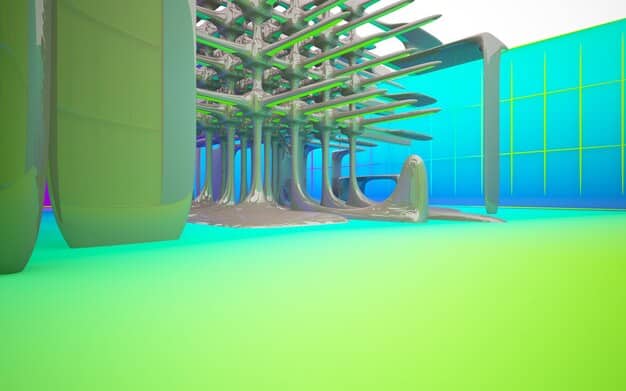
Beyond environmental concerns, ethical labor practices are gaining prominence. The animation industry has historically faced issues related to long working hours, tight deadlines, and sometimes precarious employment. There’s a growing movement towards ensuring fair wages, reasonable work-life balance, and fostering inclusive and supportive work environments. This focus on staff well-being is not just ethical, but also contributes to higher quality output and reduced staff turnover.
Diversity, Equity, and Inclusion (DEI) initiatives are also being actively pursued within animation studios and production companies. This involves actively seeking out and promoting talent from underrepresented groups, ensuring that the creative teams behind animated series are as diverse as the global audiences they serve. This commitment to ethical and sustainable practices reflects a broader industry shift towards more responsible corporate citizenship, recognizing that a healthy planet and a healthy workforce are essential for long-term creative flourishing.
The rise of independent and experimental animation
While blockbuster studios continue to dominate, a vibrant ecosystem of independent and experimental animation is flourishing, offering a crucial counterpoint to mainstream productions. This segment is less constrained by commercial pressures, allowing for bold artistic choices, unconventional narratives, and groundbreaking visual styles that often define the cutting edge of the medium.
Funding platforms like Kickstarter and Patreon, coupled with increased accessibility to professional-grade animation software, have democratized the production process. Animators can now bypass traditional gatekeepers, connect directly with their audience, and secure funding for projects that might otherwise be deemed too niche or experimental for larger studios. This has led to an explosion of creativity and diversity in animated series.
Creative freedom and niche audiences
- Unconventional Storytelling: Narratives that defy traditional structures and genres, exploring unique themes.
- Artistic Innovation: Experimentation with diverse animation techniques, challenging visual norms.
- Direct Audience Connection: Creators build loyal fan bases through transparency and direct engagement platforms.
Many independent animators are operating as single-person studios or small collectives, utilizing a lean and agile approach. This enables them to maintain complete creative control over their projects, fostering highly personal and distinct artistic visions. The success of some of these independent series on streaming platforms, or through viral online distribution, demonstrates a clear appetite from audiences for content that pushes boundaries.
Experimental animation, often characterized by its abstract nature or non-linear narratives, serves as a crucial incubator for new ideas and techniques. While not always commercially viable on a large scale, these works inspire and influence mainstream animation, gradually introducing new stylistic elements and storytelling approaches to a wider audience. The interplay between independent and mainstream animation creates a dynamic feedback loop, ensuring the art form continues to evolve in unexpected and exciting directions. This underground movement is a vital part of what defines the future of animation.
| Key Trend | Brief Description |
|---|---|
| 🚀 Evolving Tech | Real-time rendering, AI, and VR are revolutionizing production efficiency and creative possibilities. |
| 🎯 Adult Narratives | Series increasingly tackle complex, mature themes for diverse adult audiences. |
| 🌍 Global Stories | International collaborations bring diverse voices and universal themes to the global stage. |
| 🌱 Eco-Friendly Practices | Focus on sustainable production and ethical labor practices throughout the industry. |
Frequently asked questions about the future of animation
▼
AI and ML primarily serve as powerful tools to automate repetitive tasks, such as lip-syncing, motion capture processing, or basic character rigging. This allows human animators to focus more on creative nuances, storytelling, and refining complex movements, significantly enhancing efficiency and quality without replacing artistic talent.
▼
Modern animated series for adults delve into sophisticated themes, complex psychological plots, and diverse genres like sci-fi, drama, and satire. They often mirror real-world issues, featuring deeply developed characters and narratives that challenge conventional perspectives, making them resonate profoundly with mature viewers looking for depth.
▼
International collaborations merge diverse artistic styles, cultural narratives, and production expertise from different regions. This enriches the visual and thematic content, leading to unique hybrid animation styles and stories that possess universal appeal, fostering greater global understanding and broadening audience reach for series.
▼
Interactive storytelling transforms viewers into active participants, allowing them to make choices that influence the plot’s direction or character development. This can manifest through branching narratives, companion apps with AR elements, or future VR/MR experiences. The goal is to create a more immersive and personalized viewing journey beyond passive consumption.
▼
Yes, there’s a growing push for sustainability in animation production. Studios are focusing on reducing energy consumption by optimizing rendering processes and using greener technologies. Additionally, ethical labor practices, fair wages, improved work-life balance, and strong DEI initiatives are becoming core components of responsible studio operations.
Conclusion
The animated series landscape is undergoing an unprecedented transformation, driven by technological leaps, evolving narrative ambitions, and a profound global interconnectedness. From the sophistication of AI-powered production pipelines to the expanding horizons of adult-centric storytelling, the medium is shedding old stereotypes and embracing its full potential as a powerful, versatile art form. The future promises not just visual spectacle, but deeply resonant, culturally diverse, and increasingly interactive experiences, ensuring animation’s continued role as a leading innovator in the world of entertainment.
